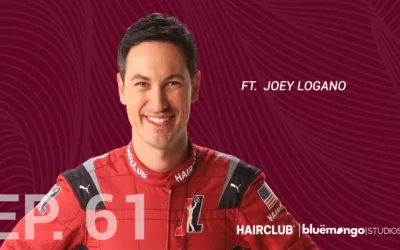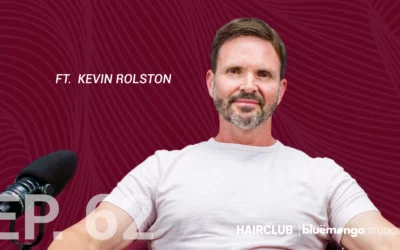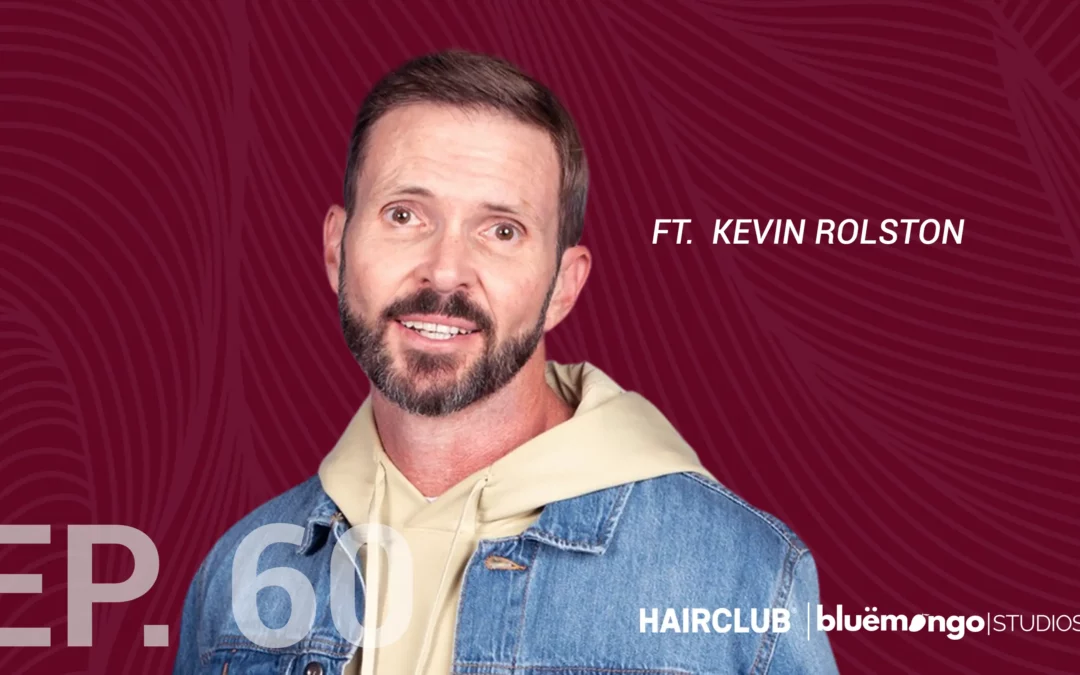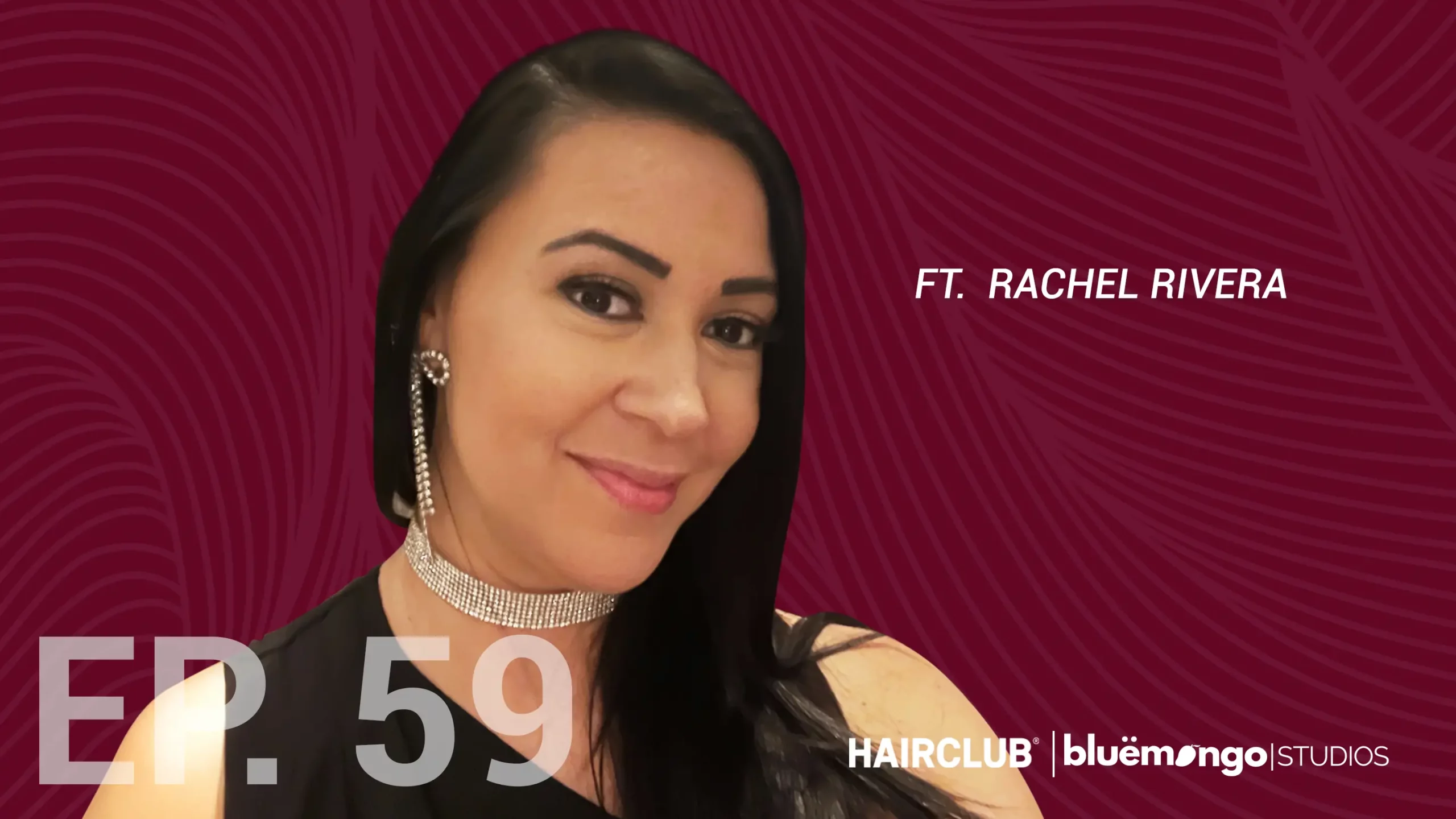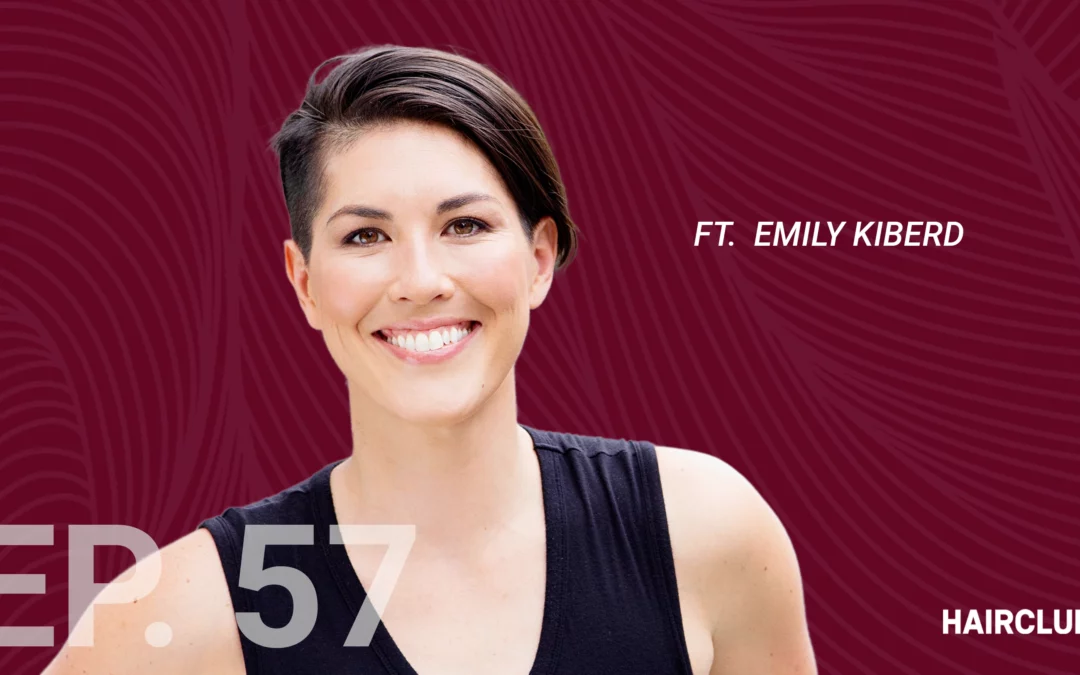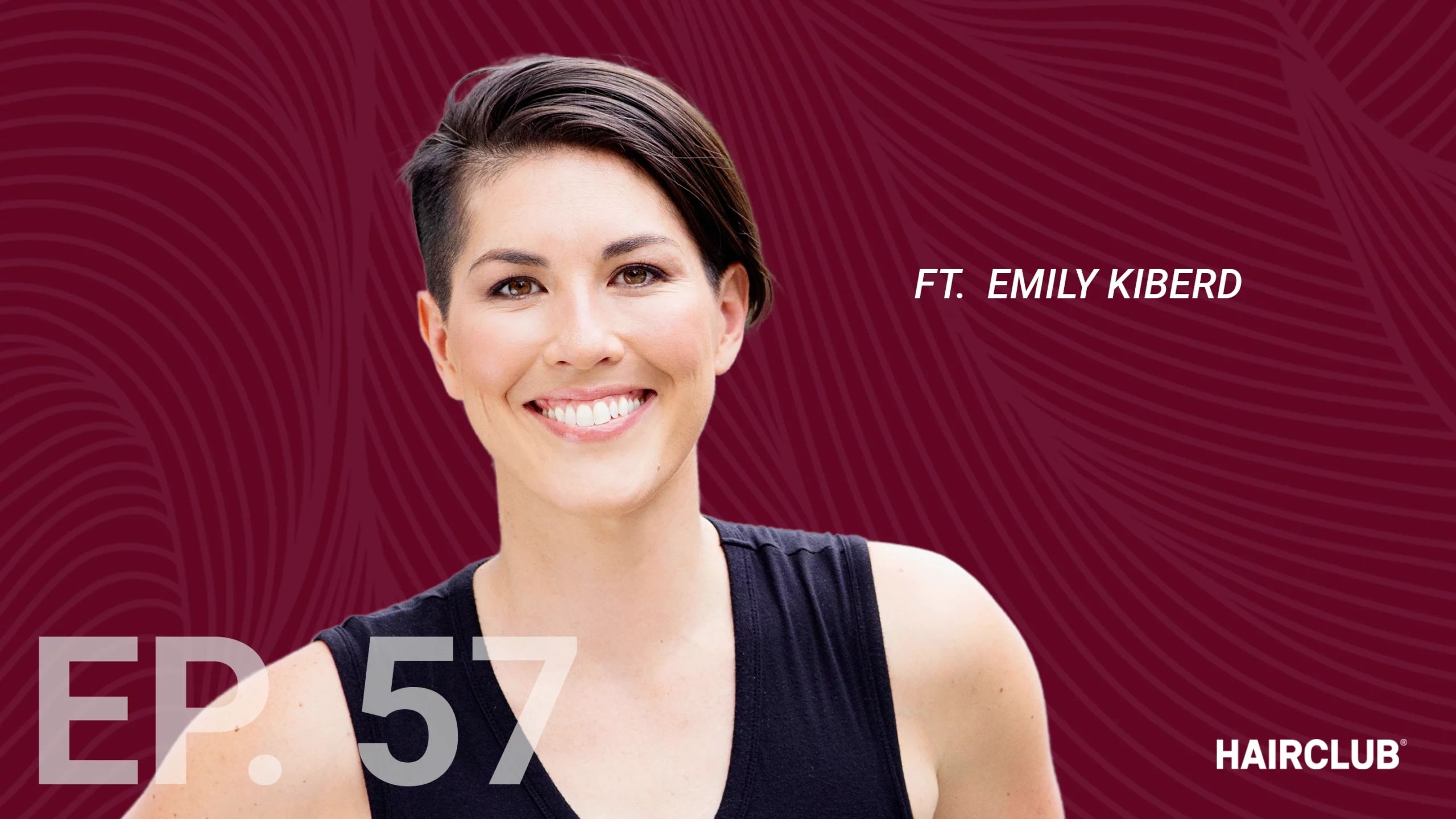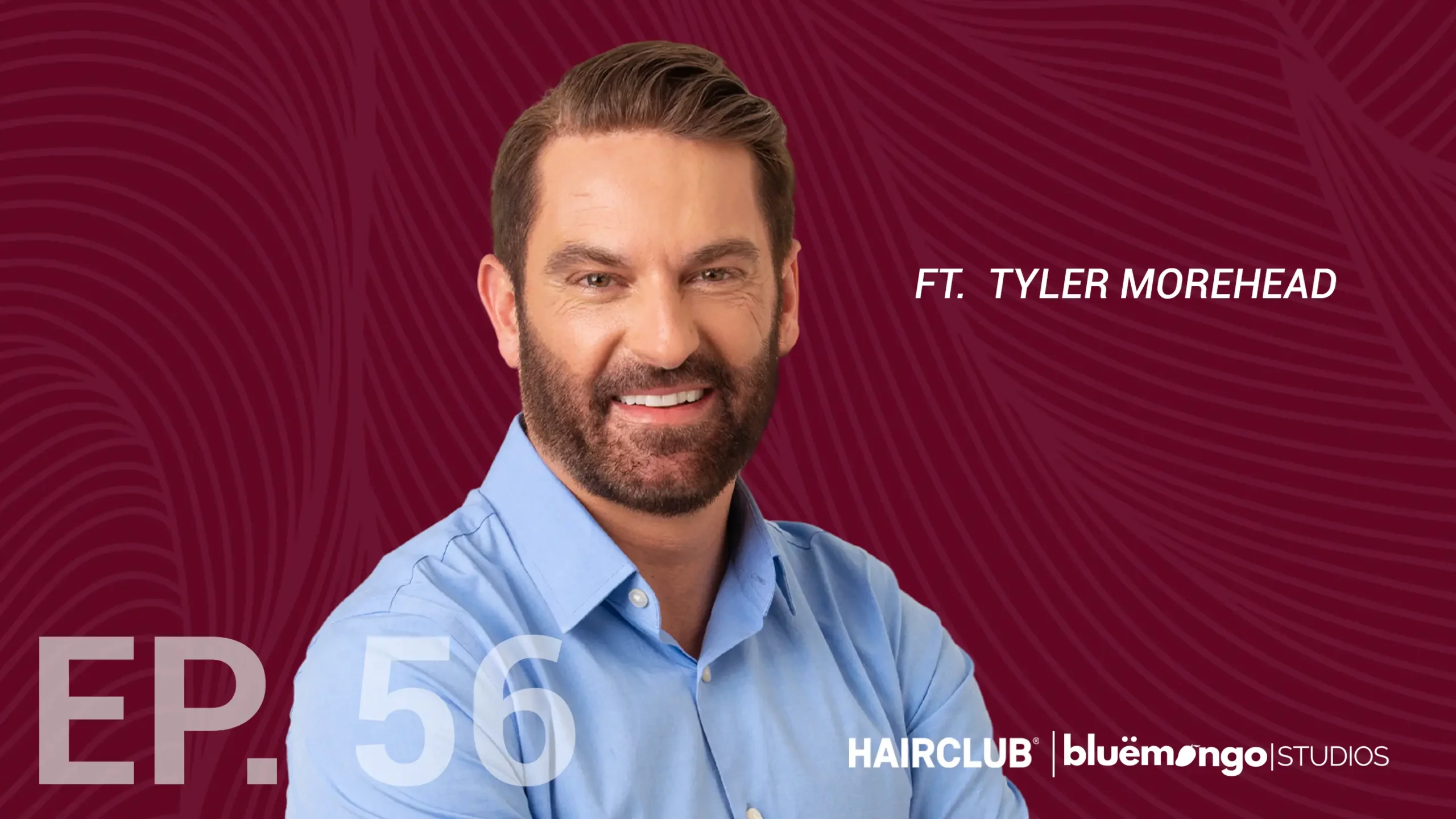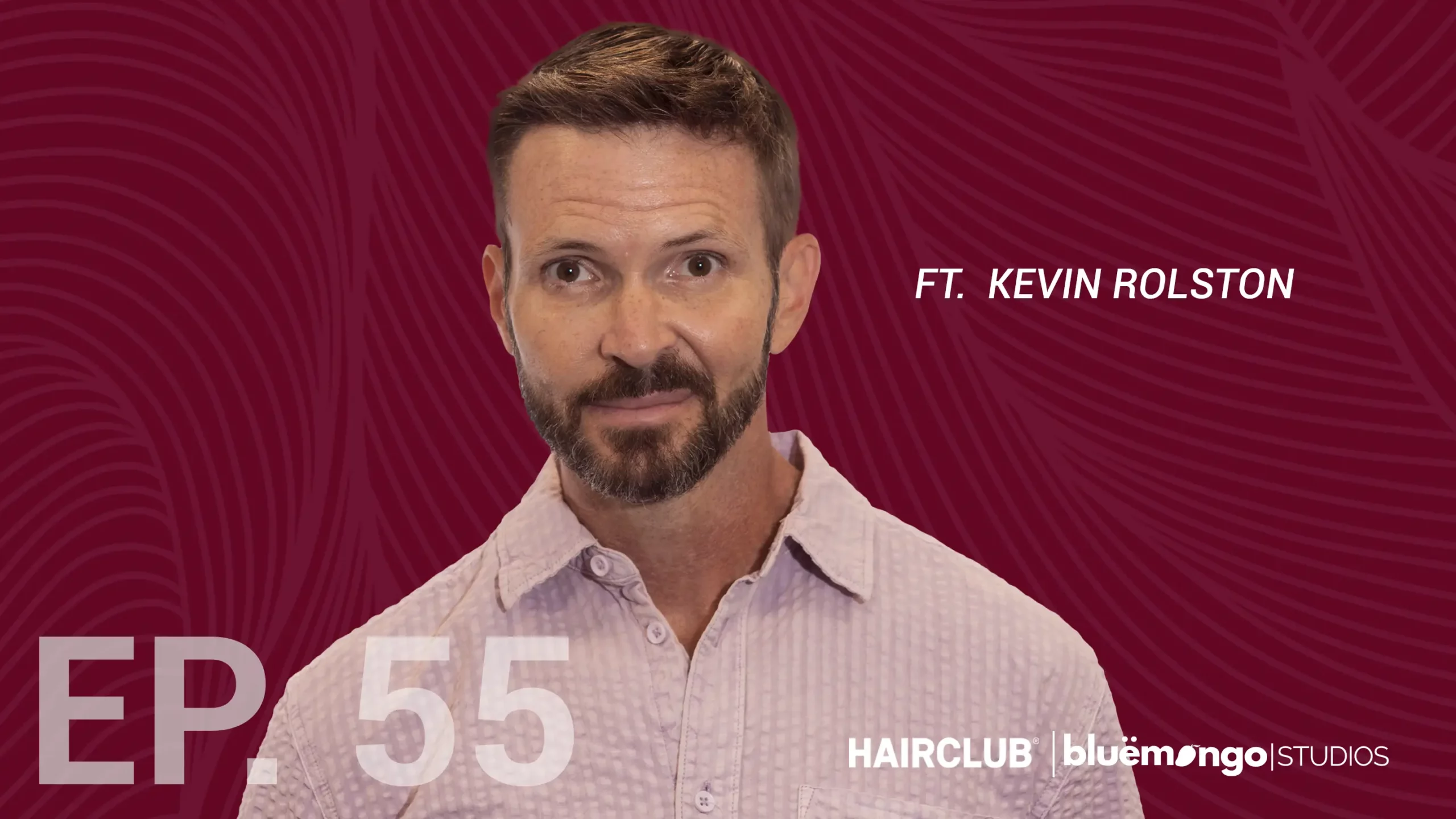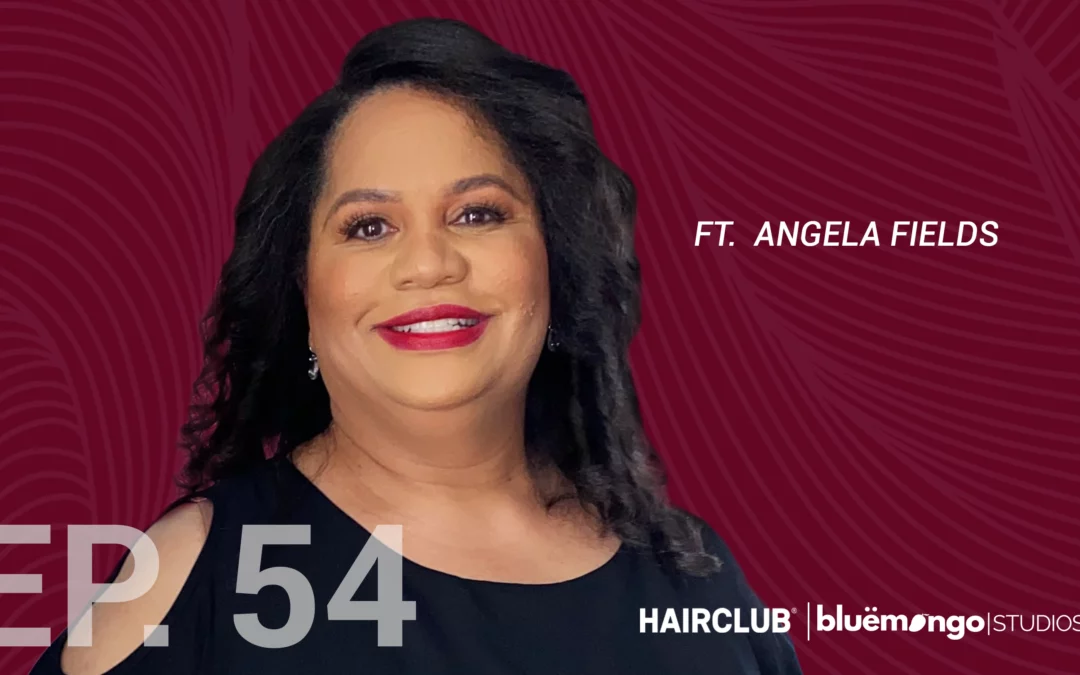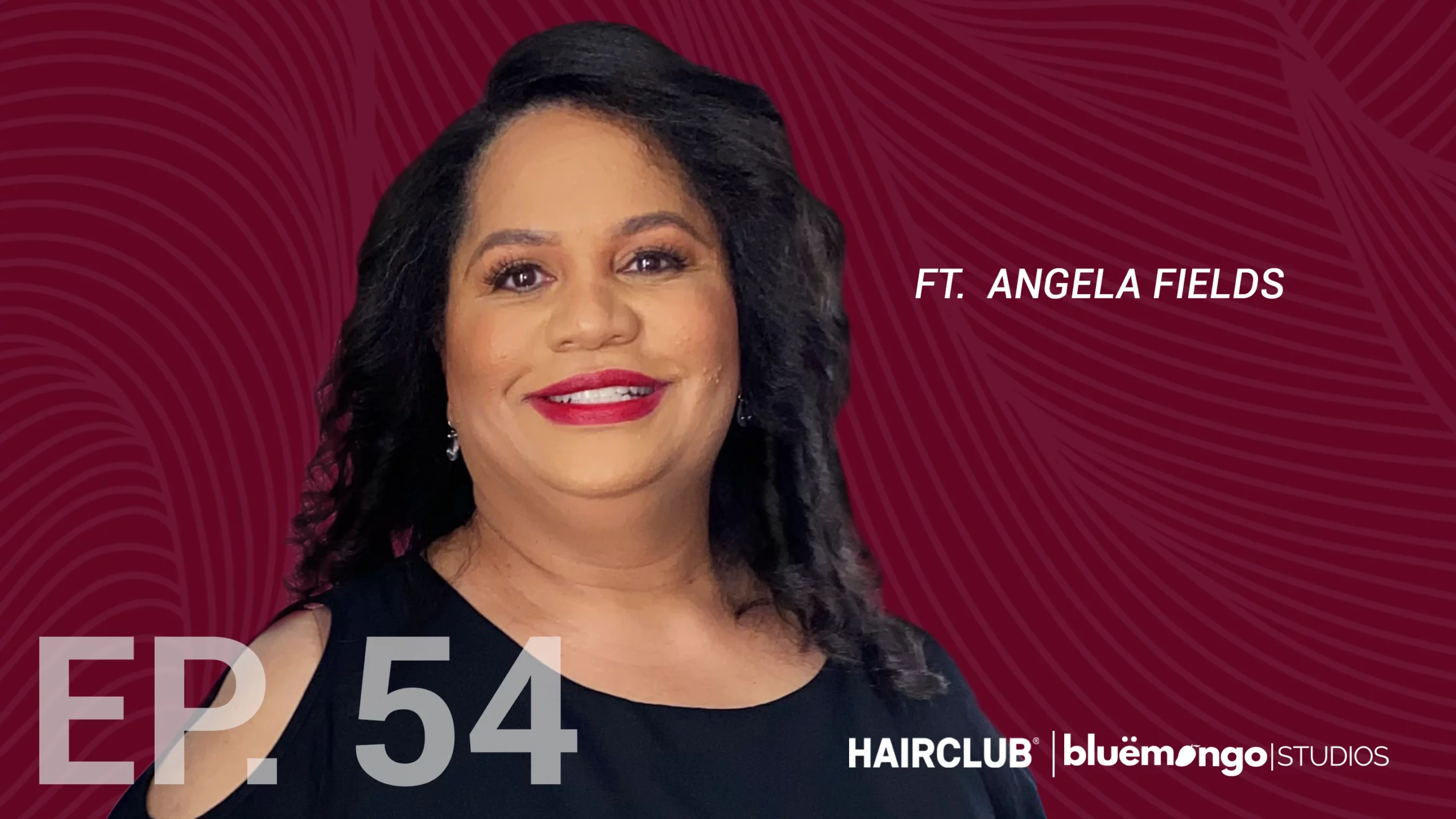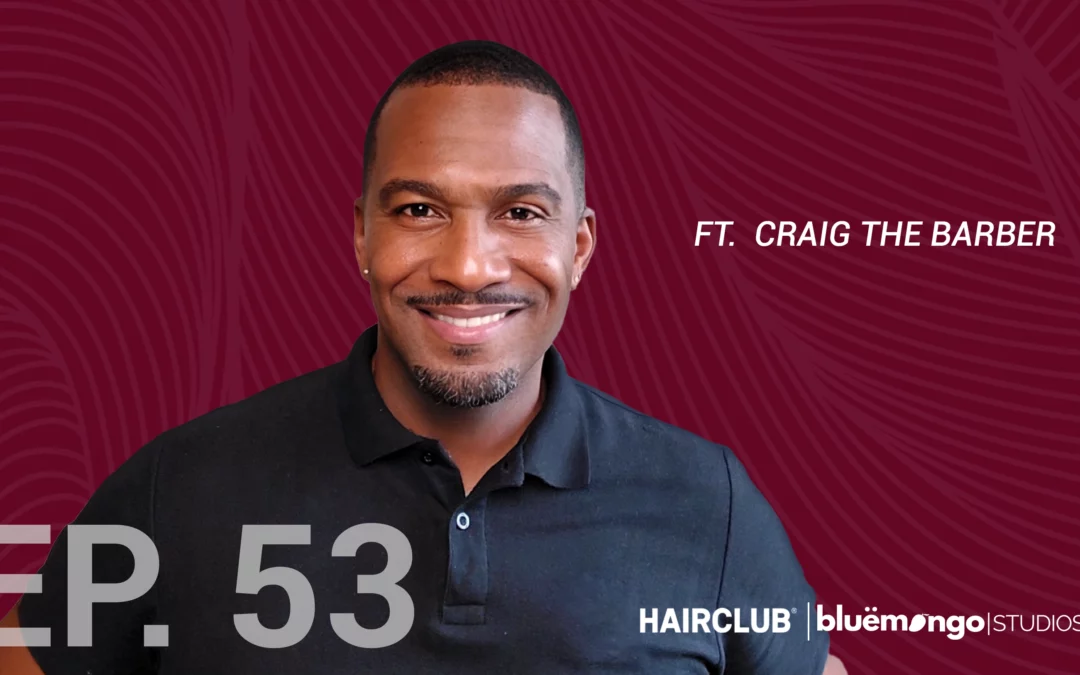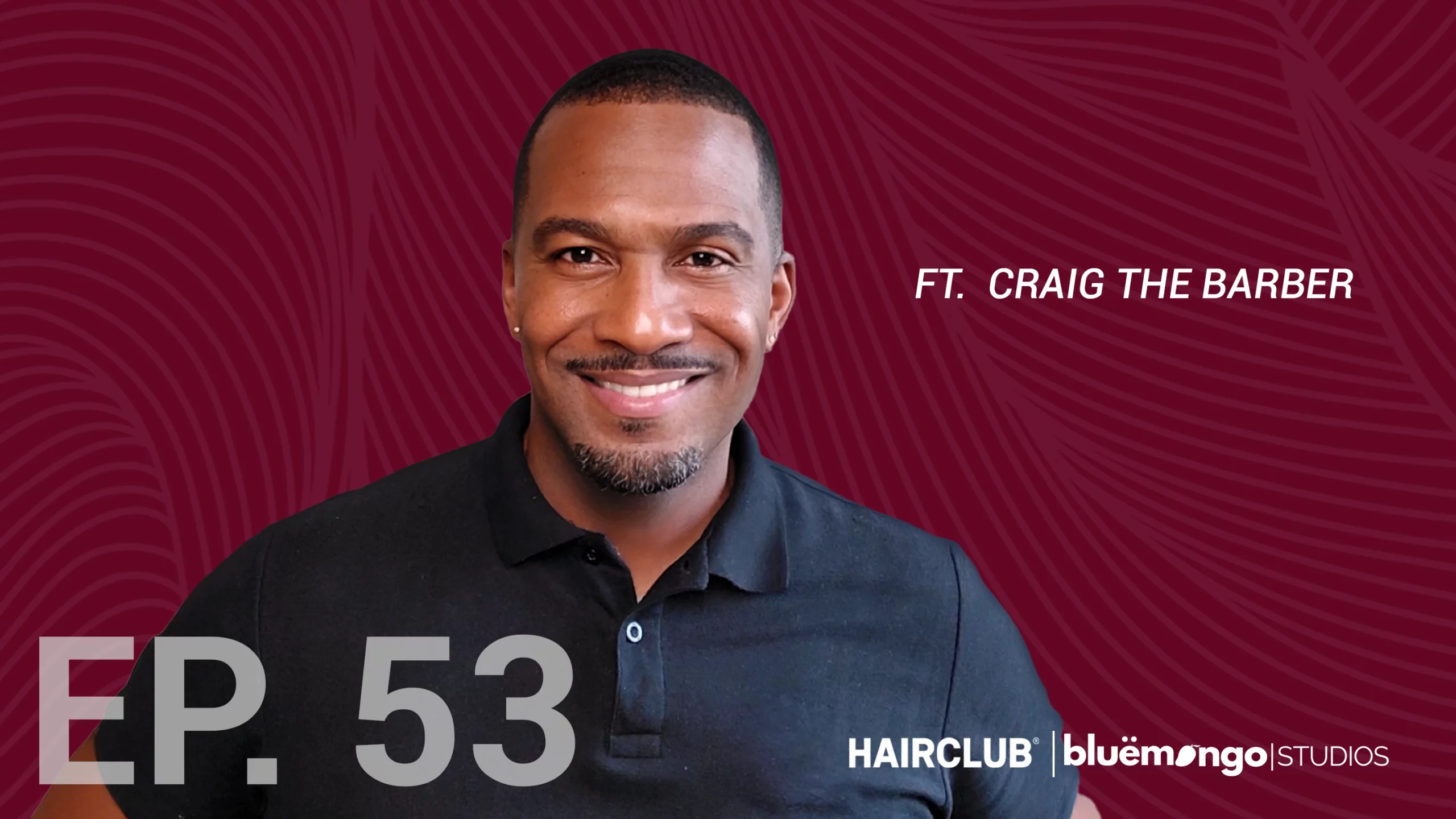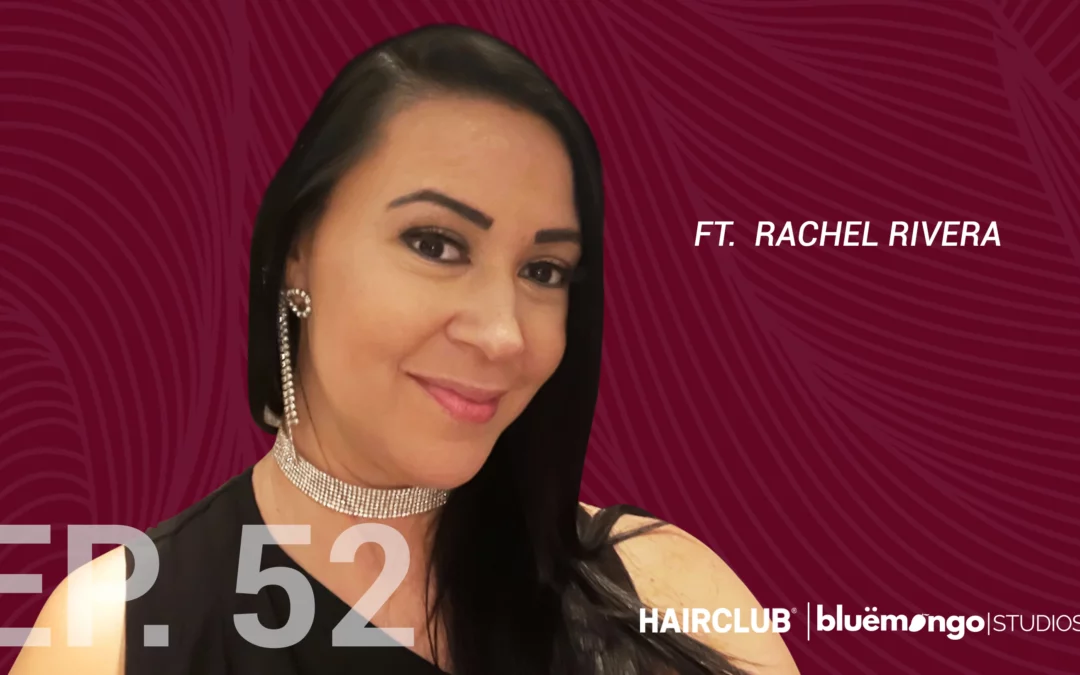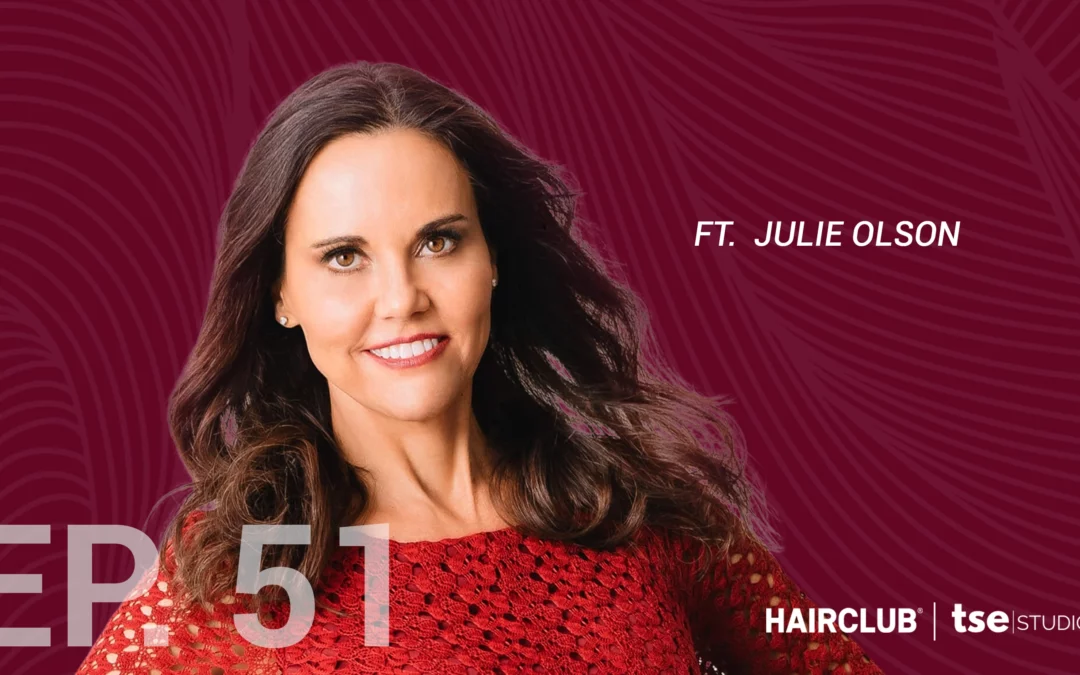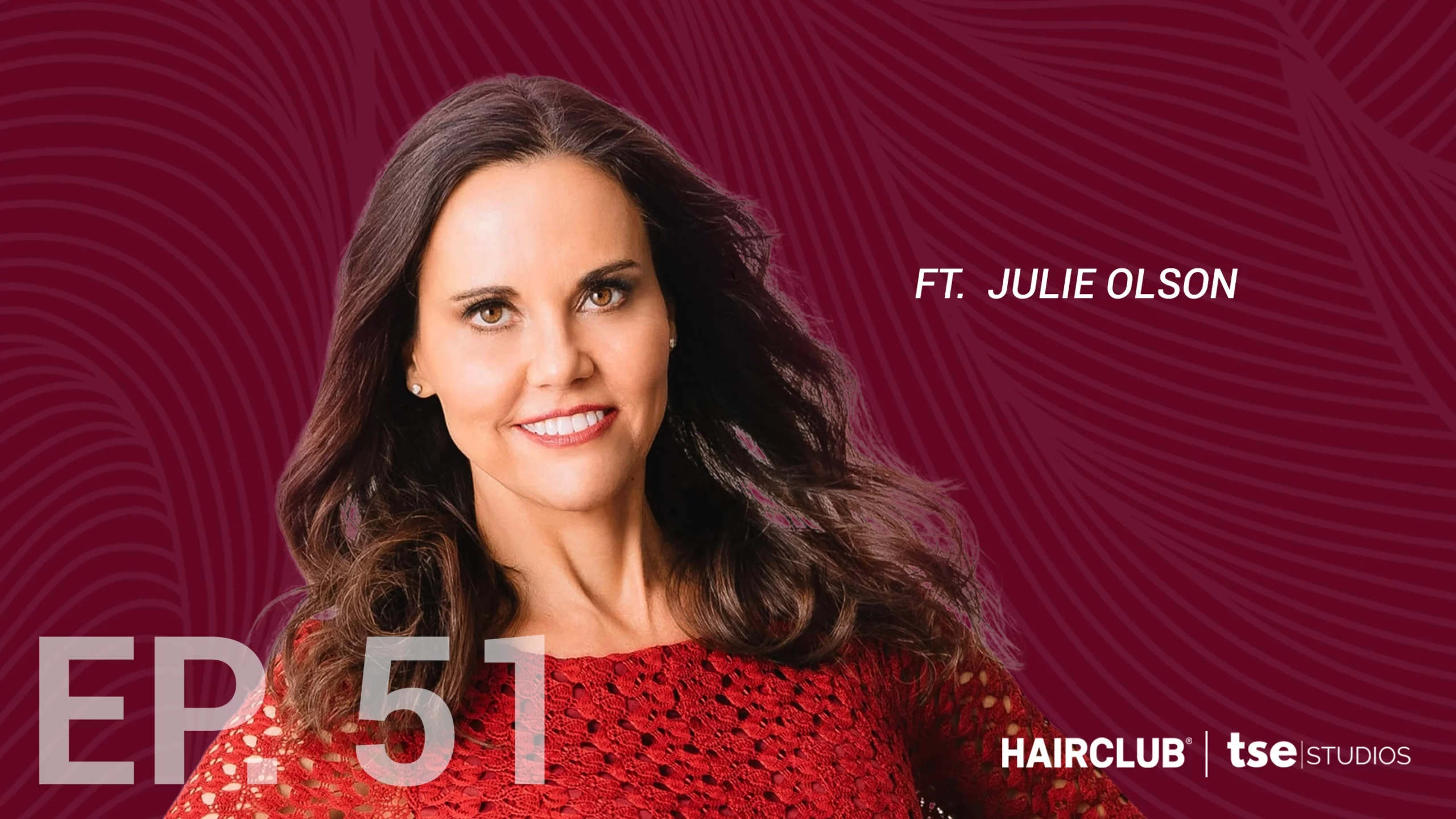Joey Logano on NASCAR wins, playoff pressure, and how HairClub helps him stay confident on and off the track.
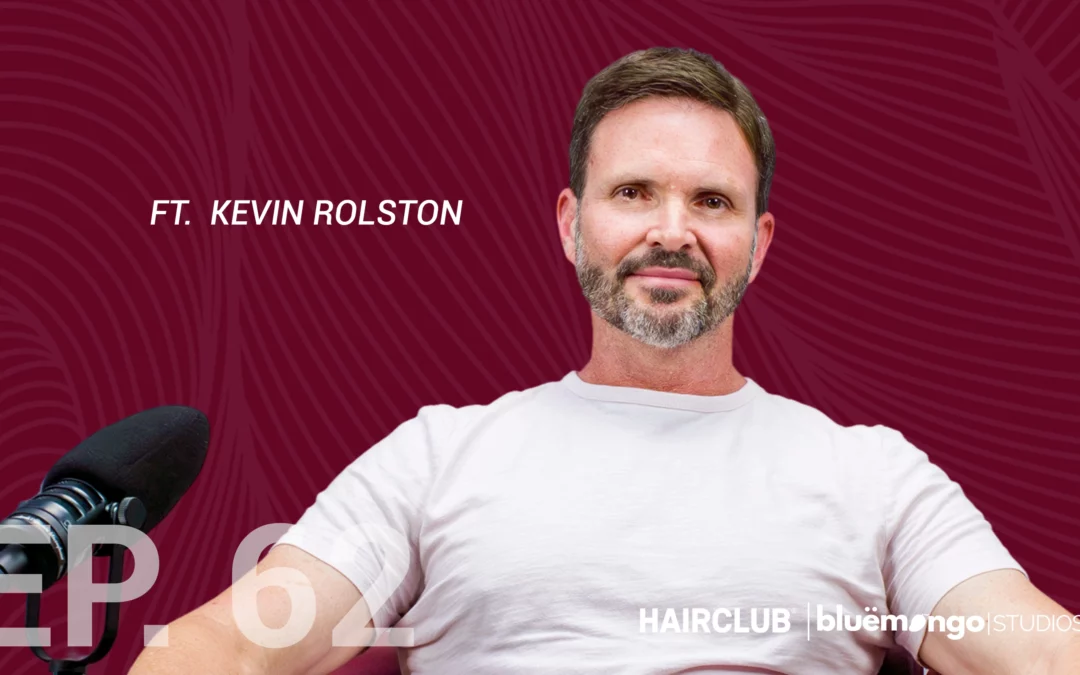
Lights, Camera, Confidence
by Julian Miranda | May 27, 2025 | Episode
Episode 62
Lights, Camera, Confidence
Exploring HairPod’s Journey So Far
Twenty-five years ago, I started experiencing hair loss and began exploring different ways to manage it. With so many hair products out there, it was a struggle to find the right one to bring my hair back to life. That’s why I created and became the host of this podcast. I became an advocate not just for men, but also for women and children who experience hair loss. As you may know, it doesn’t always stem from one problem. Hair loss can come from using the wrong product, stress, or health conditions like alopecia. This is why my guests and I explore various hair topics to help you become informed about hair loss and how you can reclaim your crown.
Good Hair Vs. Bad Hair Health
One question Donald asked me was about the difference between good and bad hair health. How can you even tell if your hair is healthy if you’re not actually losing any of it? One way is to have a professional at a HairClub examine your follicles. With the tools we have now, we’re able to dissect hair follicles at a microscopic level to truly see the hair’s health. This allows you to make informed decisions on the next steps to improve and maintain it.
Experiencing Hair Loss as a Public Figure
Hair is often tied to your identity, and losing it can have profound effects – for me, it was a nightmare experience. While some men might be fine with shaving their hair completely off, for me, being in the spotlight, it wasn’t so easy to deal with. Posting pictures and seeing others comment on my bald spots really made me lose confidence. HairClub allowed me to get my confidence back and share the knowledge I’m sharing with you all today.
HairPod Season 2: Expect Exciting Changes!
When he’s not chasing the checkered flag, Joey is focused on being present for his wife and three young kids. He gives listeners a peek into off-season life—think four-wheelers, building trails, and plenty of outdoor fun. The Loganos’ family vacations? Non-stop action from sunrise to bedtime!
Book a Complimentary HairClub Consultation Today!
Thanks for listening to HairPod. We hope you enjoyed this episode. If you did, please leave us a rating or review wherever you get your podcasts. If you’d like to connect with us on social media to share your story, check us out on Instagram @HairClub. HairPod is a production of TSE Studios. Our theme music is from SoundStripe.
Episode.62 Transcript
HPod 063 | Kevin & Donald Transcript
Donald Kelly [00:00:02]:
But all shampoos are created equal, right?
Kevin Rolston [00:00:04]:
No, not at all. Not even close.
Donald Kelly [00:00:08]:
So it’s just great marketing that’s out there with some of them.
Kevin Rolston [00:00:10]:
Well, that’s the big part that really is exposed on the HairPod is the marketing that goes into hair loss and hair products and what not to believe. There are so many different myths that we exposed and we busted and just shot right through a lot of these things that today, every day, there’s not a day I don’t go through scrolling through Instagram or social media and I see something that we have exposed already on the HairPod and said, look at that price. And there are people that in the comments you can tell are buying it like crazy. And I feel so bad for them because you know that they have just, they got you caught in another trap and you’ve just thrown your money away and something is going to be ineffective. My name is Kevin Rolston and I am the host of the HairPod. Yes. By the HairClub. Now, I’ve been doing hair loss wrong for 25 years and I host the HairPod so that hopefully you cannot make the same mistakes that I did.
Kevin Rolston [00:01:16]:
It was 25 years ago and I noticed from a photo that I was really starting to lose my hair. Crown of my head, big old bald spot. Terrifying. You know, I thought I got somebody that was going to give me great hair advice. I was completely wrong. I bought the wrong stuff. I tried everything. I spent a ton of money.
Kevin Rolston [00:01:34]:
And I don’t want you to make the same mistakes. I want you to join us on the HairPod and get the information you need. First, you got to actually get a diagnosis. What is causing your hair loss? There are many things that could be doing it. It could be something genetic, it could be something environmental, it could be stress in your life because somebody’s driving you crazy. But we can help you identify that. And then we’re going to help you find a solution that’s going to work for your unique needs. Because not everybody’s going to have the same hair loss, Sol.
Kevin Rolston [00:02:01]:
That’s why coming to the HairPod and to the HairClub is so important, to save you time, money and all the aggravation. And trust me, I know hair loss is very painful. And we address all that, the emotions that come along with it. But you know what the beautiful thing is? You’re going to walk away confident that you’re going to find the solution so you don’t have to suffer with the self esteem issues. You’ll get the confidence and the hair that you need make sure you join us on season two of the Hair Potential. We’re going to be doing new things. We’re going to be introducing video because we realize that hair loss is a visual thing. It’s great to hear and the stories are emotional, but to actually see what’s going on.
Kevin Rolston [00:02:39]:
Maybe you can identify your own hair loss issues by watching us instead of just listening to us. Plus, we’re going to be telling all the real stories, stories that may connect with you. People walking through their own journeys of hair loss. Maybe you identify with it, maybe you realize that that’s what’s going on with you, and then you’re going to get your solution. That’s what we’re about. We’re about letting you know that you’re not alone, that there are many other people going through exactly what you’re going through. Men and women, there’s so many different stories, and that’s why we still have so much story to tell. And that’s why I hope you join us for season two of the HairPod.
Donald Kelly [00:03:17]:
Hey, everyone. Welcome to the HairPod. And yes, I am not the host. Kevin is the host. My name is Donald Kelly and I was behind the camera a lot in the production side. But today we have the rare opportunity that we put Kevin on the other side of the mic, and we’re excited to be able to talk to him today and to learn a little bit more about the direction that hero pod is going in and some of his experience as we wrap up this season and prep for the adjustments that we’re making to the show. So, Kevin, how does it feel to be on that side?
Kevin Rolston [00:03:53]:
First off, it’s a little bit different. You know, it is odd, you know, to change the oppositions, but it’s. It’s great. You know, it’s. It’s nice. And, you know, the one thing about, with the HairPod is it’s not even so much that I ever really interviewed anybody. It was just an ongoing conversation about hair loss and what caused it and, and how to fix it. So, you know, that was the great thing about it is I feel like sometimes I almost was getting interviewed in some of the episodes as well, because of the conversations that we were so many of our guests.
Donald Kelly [00:04:22]:
Yeah, I noticed that with some, as we were listening and doing post edit with some of the conversation, it was. It almost felt like in some of them. Are we supposed to be hearing this? Like, it sounds like you guys were having an intimate conversation with folks. And one story I remember in particular was, I remember Heather’s story. Well, she was this. The model, the beauty.
Kevin Rolston [00:04:43]:
Yep.
Donald Kelly [00:04:43]:
Beauty contest. And in Heather’s story was just like she’s talking about her personal journey, her family life, and how the impact of, you know, just like what a hair loss had on her early on, then went into her professional career and. Yeah, but it really gave me that essence because I think in that episode, you started talking about some of your experience as well, or shared some of your experience too.
Kevin Rolston [00:05:06]:
Yeah, well, that’s, you know, the one thing that was great about the hairpin. You talked about the intimacy of the conversations. Because those kind of conversations are things that a lot of people just don’t ever really feel comfortable enough with anybody to talk about.
Donald Kelly [00:05:17]:
Yeah.
Kevin Rolston [00:05:17]:
And to be able to find somebody where you’re on the same footing and you’ve kind of gone through the same thing.
Donald Kelly [00:05:27]:
So being like very intimate, like I can imagine there’s a lot of people who found value with the podcast in general just because of the simple. They can relate to the stories. Did you find yourself relating to any one story in particular? Any of the guests?
Kevin Rolston [00:05:44]:
Yeah. You know, I think the thing that was so great about the HairPod was, you know, you had referenced a little bit about the intimacy and what that’s about, and it really established a platform for people that have something that they’re very self conscious about. And it’s hard to talk to your friends about these kind of situations. And even if you did, you’re not really talking to somebody that can give you much help because there’s not a lot of people that really know a lot about hair loss. There’s so many different remedies that are out there. And that’s what we found out through the course of doing the HairPod is just how many different paths there are to success. And there may not be one path that works for every single person. And so sometimes part of that journey is you finding what truly is working for you.
Kevin Rolston [00:06:26]:
And now, especially with social media going, there’s just so many options that are out there and people are throwing away so much money on things that are not really getting to their goal. And that’s what’s really self defeating, is to continue to look in the mirror and in your bank account and it’s getting shorter on both ends. It’s a lose lose. And, you know, Hairpop really was there to try to make it more of a win win, where you see results and you’re saving money at the same time. Yeah.
Donald Kelly [00:06:54]:
I remember hearing some of when I was speaking with the HairClub team at One point about how individuals came directly from the podcast, and I don’t know the end story of those individuals. We need to figure out who those people are and get their stories. But there are people that came back and engaged in some kind of help because of the messaging. And like you said, there’s a lot of different opportunities for folks wherever they are along the journey. Talk to me about some of your major. Your major takeaways. You mentioned the idea of the intimacy of the show being the host, but what are some of your major takeaways as you heard stories from individuals?
Kevin Rolston [00:07:37]:
Well, there’s just so much to learn to have different people’s perspective on hair loss, because I came at it from just one direction. I was somebody that is doing more the typical male pattern baldness. But as we talked about it, you really start looking into the lives of not just men and the different reasons other than a genetic hair loss. You’re talking to women that could have sometimes emotional conditions. Yeah. Sometimes it is a diet, it’s nutrition. There’s just so many different factors that go into it. And so even though I got this worldview of people’s hair loss journeys, I then realized that it’s so much more complicated.
Kevin Rolston [00:08:16]:
And that’s why what we did in HairClub in our first season was amazing. But, you know, we really just scratched the surface of everything there is to.
Donald Kelly [00:08:24]:
Still talk about, no pun intended. Scratching the surface. But, you know, I think that’s one of the pieces that I took away from it. So I’m going to share my ignorance at this point. I knew that if anyone mentioned hair loss, I automatically thought about dudes. And then it wasn’t until some of those first couple episodes and then ramping up, prepping for the show to kick off the season that I realized and learned from the team that there was a lot of women with hair loss challenges as well. It may show itself in different ways, but that was one of the components. And then really, really, really ignorant on this one.
Donald Kelly [00:08:58]:
Now, Alopecia.
Kevin Rolston [00:09:00]:
Yeah, alopecia.
Donald Kelly [00:09:01]:
Alopecia. Yeah, alopecia. So with alopecia, I felt like I saw people that didn’t have any hair at all. In my mind, I thought maybe were cancer patients.
Kevin Rolston [00:09:11]:
Right.
Donald Kelly [00:09:11]:
But then I found out alopecia, I mean, it can work in different ways, but it can have to. You know, could it be fully bald or it could be like patches. And then one of my friends, kids also had it. And I learned that HairClub even focused on kids. Talk to me about this because again, you paint a wider picture for somebody that may not necessarily have the traditional hair loss challenges, but it did educate me on the different types of. It made me more aware, Kevin. And it also helped me to look at not so much preventative, but what are some things that I could do to help right now, you know?
Kevin Rolston [00:09:48]:
Yeah. You know, the HairPod itself, and what I thought was unique with it, is even somebody with fully healthy hair could listen to the HairPod for sure. They could learn a lot of things that they could be doing for their own hair health. Because even if you’re not dealing with hair loss issues, there are a lot of people that are dealing with brittle hair or hair that’s not in very good conditions. And listening to the HairPod, you would pick up the right things to use, whether it be vitamin serum, shampoos, diet, getting sleep, all those kind of things, just even lifestyle choices. And also things that you do with your hair, how you wear your hair, what you put over your hair, things like that are all really factors. And so for men and women, there are so many things that if your end goal is not to say, I’m worried about losing my hair, but I don’t have good hair health, there are a lot of people that are not dealing with any baldness issues that do not have good hair health. Kind of like you take care of your body and you can see different levels of health in your body.
Kevin Rolston [00:10:40]:
It’s the same thing with your hair, and they’re all connected.
Donald Kelly [00:10:48]:
What does good hair health look like versus bad hair health?
Kevin Rolston [00:10:53]:
Well, you know, you can see it’s. It’s just got a body to it. It’s got a thickness. And that’s the one thing with HairClub that is amazing. If you go in there or if you talk to somebody that is a professional, they can go in and really analyze and see the width of your hair. They can see the follicles. There are so many things that, with a microscopic level now, that they can go in and they can see different levels of your scalp. And what is happening with that is going to affect your hair.
Kevin Rolston [00:11:19]:
And so going in, looking at the scalp, looking at the follicles, looking at the diameter of the hair as well, those are the things that kind of let you know, okay, are you doing the best that you possibly can? And people really can pick up just how full their hair is, how it looks, how it bounces, the sheen, the color. There’s so many different factors of radiance when it comes to hair. And the HairPod provides information into all those things.
Donald Kelly [00:11:41]:
So along those Lines of healthy hair, not so healthy hair. Maybe takeaways and tips and all that jazz. Let’s go further on the. I think there are many of us that just don’t know, I guess, what’s some of the basic things that I could do? Because you mentioned like hair diameter and hair width, and I’m thinking like, dang, how much know how long that sucker is or how wide that that is. But what is some of your experiences or things you took away from guests? The danger of not being hair health aware?
Kevin Rolston [00:12:16]:
Yeah, the things that. And why I think it matters for so many people is you care about your looks and you want to make sure that your hair is as healthy as it possibly can be. And typically, too, for some people, it’s when they grow their hair a little bit longer than they might notice that their hair health is not exactly where they want it to be. And so what the HairPod did was it really just kind of brought through all this information and broke down all the different things that make hair unhealthy and sometimes why you’re losing your hair. And it opened up a lot of stigmas, too. There were a lot of stigmas that we’ve had to try to get through when it comes to hair loss. And even HairClub itself, you know, was branded originally as HairClub for men. And then they realized that there are a lot of women that were dealing with this.
Kevin Rolston [00:12:59]:
But especially for women, the hair loss issue is a lot more sensitive and even more taboo to talk about. And so for women, a lot of times they would get wigs, they’d be able to hide it in a way that you wouldn’t know or you would think that the wig was their choice, not something that was done out of necessity because they’re getting thinning hair. And women, they lose their hair a little bit differently than men. They call it male pattern baldness because there’s typically a pattern to how men lose their hair. But with women, a lot of times it is more spread out, and so the hair just becomes more thin. And that’s why for women, and sometimes it’s color, there are other things that you could be doing, even just stress. Pregnancy is one of those things that wrecks your hair health. And so for women that are just even dealing with that, you may have a period in your life where your scalp is not healthy, your hair is not healthy because of things that might be happening.
Kevin Rolston [00:13:47]:
There are illnesses and cancer and different things like that. That’s all going to affect your hair health because everything in your body is Connected. And so just being aware of that and if you’re in a special circumstance like cancer, pregnancy, something like that, the HairPod offered a story. And women who have gone through it and what they’ve done, what the symptoms are, how you know what’s causing that effect. And then more importantly then, here are the solutions that you can take so you can go right to the source of what’s going to be effective. You’re not going to get duped by a lot of the things you’re going to see scrolling social media and buy a lot of things that are not going to be effective.
Donald Kelly [00:14:21]:
Hair and identity. Go deeper on that again, from. Again, from the back side of the other side of the camera, the production side, we got a chance to hear. And that helped again, with my knowledge. But when it comes to hair and identity, how important or how big of a deal is that and does that make a difference, male or female?
Kevin Rolston [00:14:45]:
Yeah, I mean, for so many people, their hair is their identity. You know, we’re in a world now, especially for men, where some just shave their head and they’re okay with that. Maybe they even look better because of it. Some men just have given up.
Donald Kelly [00:14:58]:
MJ pulled it pretty well, right?
Kevin Rolston [00:15:01]:
Exactly. So, you know, some people that works for. But, you know, when it comes to men, you’re probably talking 10 to 20% that really, truly look good with the shaved head. There are other men that are going to have a bald head or a shaved head. They’re not going to look so good. And I would fit in that category, you know, if I could. It would be a lot easier, you know, to be able to do that. But I don’t look good with a bald head.
Kevin Rolston [00:15:25]:
And I realized that many, many years ago, before I even had to worry about hair loss, is I put on a bald cap for a theater thing, and I got a really good glimpse of my facial structure, and it really was shocking to me. And so that really enhanced my anxiety about hair loss. And so as I saw it creeping on, I saw myself losing the hair. That’s what really, in a sense, fueled a lot of my anxiety through my whole process.
Donald Kelly [00:15:49]:
Talk to me about that part of the story and you’ve shared it on episodes, but talk to me when you started discovering that. How did that impact you and your confidence in the world that you’re in public figure?
Kevin Rolston [00:16:01]:
Yeah, I noticed that hair loss is a lot of times, like putting on weight, where you see that one photo and all of a sudden you’re fat, because I don’t know what it is about a mirror. But when you see yourself every single day, a lot of times you don’t notice. You’re like, I look great. And then you see an old photo and where you are now, like, oh, my goodness. Hair loss is very much the same way. Because a lot of times you’re not really seeing the progression of your hair loss. Or maybe there’s a part of your head that you don’t really see. And that was my story.
Kevin Rolston [00:16:29]:
Yeah, there was a photo that was taken of me doing a karate move, breaking a board. But I’m bent over as I’m coming down to break the board. And the photo was snapped at that moment of my great victory. But the victory also showed my greatest defeat, which was a huge bald spot on the top of my head that I didn’t even realize I had at that moment. It was the first time I saw it and I became very self conscious about it. And then for 15 more years, I really tried to battle to keep that bald spot in check. And we had a dome camera in our studio and there would always be a shot and it would go to that and it would show that bald spot. And I would have to see it and face it.
Kevin Rolston [00:17:07]:
And then my audience would see it and they would comment. I’d be like, whoa, somebody’s really losing their hair. And you know, those are the kind of things that you just see. And if you’re sensitive to something, then it affects your confidence. And it’s like with anything, you know, when you, you stubbed your toe, somehow your whole body is off. Yeah. And when your confidence is shook a bit, sometimes I don’t think you fully realize how it just permeates through every different part of your life. And it wasn’t really until I got my hair at HairClub that I felt like I fully regained that confidence.
Kevin Rolston [00:17:38]:
And it was just kind of like powered up Pac man going all the way back to 100 and be like, okay, I got my confidence back. And you don’t realize that that thought’s always in your head. It’s affecting your self esteem and it’s affecting your confidence. And if you’re a person, like for me, that really needs their confidence. If you’re doing sales and so many other jobs with presentation where if your confidence is a bit rattled, it truly can affect different parts of your life, including your career.
Donald Kelly [00:18:10]:
Looking back. So you went back 100%. Now you’re PAC Man. Turn around. Now, looking at where you were during that time period when you, you didn’t treat it and customer, you Know your listeners were commenting and stuff like that. What signs do you now or things you can now see that how you were being impacted in your professional career.
Kevin Rolston [00:18:29]:
Essentially, you know, it was something where for me, in the on air studio and radio being less formal, I was able to wear ball caps almost every single day.
Donald Kelly [00:18:40]:
Yeah.
Kevin Rolston [00:18:41]:
But occasionally, even with the job, I’d have to step out. We would do formal charity events or I’d have to make a presentation or something like that where you couldn’t wear a hat. And I used to dread those events because I knew this is when I had to expose my hair and where I was. And each time you’d have one of those events, maybe it was six months since the last time you had to do that and you could just see or you’d get the comments of, whoa, okay. Boy, it’s really taken off on you, huh? And so I would dread those moments. And that was the kind of event that really stood out to me, was feeling like I would always have to try to think of my outfits and where I would be based on whether or not I could wear a hat and what that situation was going to be like, because that’s how much my confidence was rattled.
Donald Kelly [00:19:21]:
Now, I think you mentioned something here how it may impact you in the sales capacity or other professions. When we talk about most of the episodes, we have professionals from all different levels, from Joey Logano to individuals, influencers that were doing stuff like Frankie Muniz as well, like Muniz. So you got all of these different people, they’re professionals watching this episode. And she or he, maybe they’re looking in the mirror, but they’re not really seeing that bald spot from above, quote, unquote. Their confidence may be rattled. Whether it’s in a boardroom or perhaps in the classroom or perhaps in the dental office, like where they are. What would you say to them to help them to realize that they need to do an examination, so to speak, like we may know about the problem and not want to do something and afraid to do something about it is probably the best way to look at it. How would you help that person to become aware and to be mindful of their health and how this could potentially help them in their professional career?
Kevin Rolston [00:20:30]:
What I would tell anybody, if you do have that self confidence issue where you feel a little bit off because of where your hair is, I would just recommend going right to HairClub at that point. And that’s really what I would recommend anybody doing is finding somebody that truly knows this field and they can give you the proper analysis, they can give you the proper guidance and they can do everything at the proper price. And that’s why going it alone, it is tough out there because I went it alone for 20 years.
Donald Kelly [00:21:02]:
20 years.
Kevin Rolston [00:21:03]:
20 years. For the most part, I did. Even through that time, I talked to hair doctors and things like that. And what really kind of did me wrong and why I am so particular about HairClub was I went and actually did a hair transplant and went through and invested that money. But it wasn’t until after my transplant where I was talking to somebody else who mentioned they also did a hair transplant. I said, oh, that’s cool. I did the same thing. I said, but yours looks really full and great and I’m still kind of waiting for mine to take off.
Kevin Rolston [00:21:32]:
And he said, oh, I had about five or seven of these. I said, what do you mean you had five or seven? And he said, oh, yeah. He said, you know, typically one hair transplant’s not going to do the job. I was never told that. And that’s what shattered my confidence because I had somebody that was what I thought was the proper hair helper. But that key detail of saying, hey, this is probably one of many. Is this the course you truly want to go down? Because it was not a cheap procedure to do one. You know, you’re talking maybe five to $10,000 easily.
Kevin Rolston [00:22:03]:
And then by the time you get to I talked to that guy, he was 80, $85,000 in restoring his hair. And that just is not going to necessarily work for everybody that’s out there. And that’s why I would say get to HairClub. A place that has been doing it is a well known brand that has true professionals that can look at your hair and they can guide you through the process and be honest with you. And even doing the hair pod, there was something else in my initial plan that was flawed, is I had started on something called finasteride, which is really good for male pattern baldness. And I would recommend a lot of people look at that. And I did finasteride for 10 to 15 years and it did slow down my hair loss. In fact, I thought I had the solution.
Kevin Rolston [00:22:44]:
I was going to be fine, but I still progressively kept losing enough hair that over 10 to 15 years, even though it slowed, it got to the point where I had to make that ultimate choice to say, you either need to just shave your head because it was so patchy and bad, or you’ve got to get on board with HairClub. And what I learned by doing the HairPod was that in 10% of men with male pattern baldness, the finasteride is not going to be enough, and you need to do something called dutasteride. And it was through the course of doing the HairPod that I found out I was part of that 10%. And so that’s another example of improper hair guidance. I, for 10 or 15 years, spent how many thousands of dollars on finasteride that ultimately didn’t do what I was hoping it was going to do? And then I, you know, wasted the money that I had on the hair transplant and found a much better solution with HairClub.
Donald Kelly [00:23:37]:
Education.
Kevin Rolston [00:23:38]:
Yeah, education, education. When it comes to hair loss, truly, it really is everything. Unless you just like to throw your money away, then go for what I did. If you like that.
Donald Kelly [00:23:49]:
Yeah. We don’t know what we don’t know. And it’s important, it’s imperative that we get the proper education that can guide us on that. And I feel that that’s in. No matter what industry or what you do, that is a critical component.
Kevin Rolston [00:24:04]:
Yeah, it really is. And especially when it comes to hair loss, because, like I said, it is. It truly is so complex where, you know, I think if you got in for a hair analysis, not only are they going to look at just the biology factors that are going on with your hair density and health and your scalp and talk about your diet and your sleep patterns and things like that, but you’re going to get down into the emotional part, too. And there were so many people that I had talked to that had depression, anxiety, and they had some emotional issues. And stress is so bad when it comes to hair health. And you may just be in a really stressful situation that maybe somebody that you know has a terminal disease or you went through a death or a divorce, and all of a sudden, ladies, you’ve got hair loss and you don’t know why, but you sit down and talk to a hair professional and they ask the proper questions like this. They could say, I think this is what’s going on. Most likely it is the stress from your divorce that is causing your hair loss.
Kevin Rolston [00:25:01]:
So here are some things that you can do. After analyzing your diet, what shampoos you were using, and how you’re wearing your hair, we can put you on a good plan.
Donald Kelly [00:25:14]:
But all shampoos are created equal, right?
Kevin Rolston [00:25:16]:
No, not at all. Not even close.
Donald Kelly [00:25:19]:
So it’s just great marketing that’s out there with some of them.
Kevin Rolston [00:25:22]:
Well, that’s the big part that really is exposed on the HairPod is the marketing that goes into Hair loss and hair products and what not to believe. There are so many different myths that we exposed and we busted and just shot right through a lot of these things that today, every day, there’s not a day I don’t go through scrolling through Instagram or social media and I see something that we have exposed already on the HairPod and said, look at that price. And there are people that in the comments you can tell are buying it like crazy. And I feel so bad for them because you know that they have just. They got you caught in another trap and you’ve just thrown your money away and something is going to be ineffective.
Donald Kelly [00:26:03]:
What are some of the biggest deceptive things out there when it comes to hair loss that maybe pull people in the wrong direction?
Kevin Rolston [00:26:10]:
There are a lot of times there are things going to be written on the bottle. There are even some of the stigmas and things out there where they have something for men, for women. Is it really. You know, we went through some of the greater details in one of the HairPod episodes, just about that kind of branding and things that happen and the reason why they do it and products are not created all the same. And you really do have to go a little bit deeper. It’s looking at the ingredients. We covered that too. What are some things that you might see on the side of your shampoo bottle that if you see this word, that that is a no go every single time.
Donald Kelly [00:26:42]:
I love that. Kevin. There’s a lot, and you kind of alluded to this, that there’s a lot of different things. HairClub offer, again, naivete. I thought, you know, maybe folks can just pop a pill and that’s where things could start going. And, you know, back in the days, you hear about like, you know, like the, you know, your grandpa’s toupee. I did not know the depth of the solutions that were there. Talk to us about some of the most popular or some of the most popular solutions that HairClub does offer.
Donald Kelly [00:27:18]:
Some of them I know, like, hear me out now may sound like a little expert. Extra.
Kevin Rolston [00:27:24]:
Yeah, extra.
Donald Kelly [00:27:25]:
I know a little bit about them, but I don’t know what they are exactly. So talk to me about some of those popular solutions that are out there.
Kevin Rolston [00:27:30]:
Well, you know, it’s kind of like a sliding scale. When you go into HairClub, you have from the lower end on how much I need to somebody that is at a hair system, which is where I am. So it shows that no matter how bad the damage, there is a solution with HairClub and it starts all the way down to people that might want to wear shorter hair, but they have lost some of the volume up there. And you might even have the pigmentation where you have a lighter scalp. And then you can tell that, okay, I want it to look like a nice neat hairline. And there are things that HairClub can do so that you would have that look. There’s somebody that might have a shorter hairstyle and they’re just thinning, but they’re kind of thinning all over the place. Well, there are products that HairClub can give you to, you know, make that hair come out more voluminous and it will look like it’s going to be filled in naturally.
Kevin Rolston [00:28:21]:
And so you have solutions that come to that. And so now you’re starting to climb the ladder on just, you know, how advanced you need to get. And so that’s why depending upon where you are and what your needs are, you figure out what rung of the ladder that you’re on at the HairClub and they have the expert that is going to be able to walk it through you and look at your budget and give you a price that’s going to find a solution that’s going to work for you. So when you’re talking about HairClub and why you might go HairClub, for me, I can speak mainly to, you know, what I have in the hair system and the X strands that they provide. And you go on social media and there are other places that are providing a similar product and a lot of it is applied the same way and the same kind of things are done. But it’s only HairClub that has the technology that they do what I wear. It is something that is completely breathable, it feels natural. It’s real human hair.
Kevin Rolston [00:29:13]:
It’s something that’s styled and it is something that stays on and I never have a worry. And we did a video series where I was walking into a hurricane tunnel set in a category three and everything was fine. I’m, you know, on a jet ski, I’m in a Jeep and all these kind of things where you truly do live your life, jumping into pools, water, all those kind of things. It goes to show you just how you don’t ever have to be self conscious about your hair. And to me, that is a product that’s provided by HairClub and getting the assistance that you do. And it’s unparalleled. So that’s why I warn people to seeing some of the gimmicks that you could go to a flea market. Not even a joke.
Kevin Rolston [00:29:49]:
Flea markets do Offer it.
Donald Kelly [00:29:51]:
No way.
Kevin Rolston [00:29:52]:
They do. One in South Florida does. And I’ve talked to people and they get hot. You know, they do get hot in the summertime. You’re going to notice if you are wearing the hair like I am, you will feel it. I don’t ever notice it. It doesn’t feel different. Yeah, don’t feel different at all.
Kevin Rolston [00:30:05]:
And so that’s something why just the prestige of HairClub. And you’re looking at the company that really came in and designed this and revolutionized the market. And that’s why to me, you don’t mess around with anybody else whose name you don’t recognize and stick with the brand that you know, because they were on top of the game and they are currently now the king as well.
Donald Kelly [00:30:24]:
Yeah. Well, this is all. This is really cool. And this is why it’s so much fun to be able to create content for the show, because you can you help educate and get so much out to the masses and tell those stories. Speaking about stories. There’s some changes coming to the podcast, and I know there’s going to be a hiatus as we work towards that and preparation and some of the changes. Video is one of the changes that’s coming in a setting similar to this. Why video?
Kevin Rolston [00:30:56]:
Now, when we did HairPod, it was a great way to tell stories and hear the emotions that went through it. And as you’re sitting there, you can hear the emotions. You can feel the emotions that are there. But, you know, we are talking about something that is visual. The hair and the way that it looks is very visual. And so we can talk about alopecia and we can talk about the different forms of hair loss, but by now incorporating a lot more video with the HairPod, you’re going to be able to see those situations. Now, when you’re listening to the HairPod, you may think that what we’re talking about relates to you, but being able to see it lets you know in your mind’s eye, okay, that’s exactly what I have. And this is the right path.
Kevin Rolston [00:31:31]:
And so we just realized that the video enhancement was going to be so important to what we were going to be doing moving forward. I would expect a lot of the same where we’re going to hear the personal stories. People are going through something that you’re going through. You’ll be able to hear their path through it to see how much it matches yours. But then we’re always going to come in and provide that solution for that person, and that’s really what’s going to Be great. Because everything we’ve talked about here today and what HairClub offers is what we’re going to show what it’s like when you get into HairClub, how they analyze what is happening with your hair situation. What kind of advice could we give each and every single person? So it is only going to elevate the amount of education that you’re going to get from HairClub and from the HairPod.
Donald Kelly [00:32:09]:
And I know one of the other changes is our in person stuff as well, obviously, because we’re going to do video. You know, you can do that with remote platforms. Go deeper on why you had an emphasis on the move to in person filming.
Kevin Rolston [00:32:24]:
When you’re in person, you have a little bit more control of the environment. And so you can make sure that we can thoroughly get in and we can take a look at somebody’s hair and we can really talk to them. And the other part of it as well is you do get a little bit more of the emotion.
Donald Kelly [00:32:38]:
Yeah.
Kevin Rolston [00:32:38]:
There’s something about doing a video call, which is great, but if I truly want to tap into the emotion, and the emotion is so important on this, because you really do. You feel hair loss in your soul. That’s why it’s so powerful for so many people, is the emotions that come up along with it. And you don’t fully get that unless you’re sitting in the same room with somebody and you’re face to face. So we expect the emotional level of the HairPod to increase and also the visual part, which is going to make it better for the viewer and listener.
Donald Kelly [00:33:03]:
And I know what’s one of the exciting part is, you know, getting more. There are local people around here in South Florida has tons of stories or people of hair loss, no matter where they are. And we’re tapping into those folks that are right here. And I think it’ll be a little bit exciting for that, too.
Kevin Rolston [00:33:20]:
Yeah.
Donald Kelly [00:33:21]:
So.
Kevin Rolston [00:33:22]:
Well, the thing that’s going to be great about showcasing stories that are in South Florida, where HairClub’s headquarters are, is you’re going to see a part of the world that is all about appearance. And so it really, truly is.
Donald Kelly [00:33:36]:
Are you sure? In Miami, it’s about appearance.
Kevin Rolston [00:33:39]:
So when you see something coming out of South Florida, you have the best of the absolute best.
Donald Kelly [00:33:45]:
Yeah.
Kevin Rolston [00:33:45]:
And the thing that’s going to be great for people, no matter where they are, is just how many HairClubs nationwide and globally there are that wherever you’re listening or watching, you can say, okay, I see it’s coming from South Florida. But it’s going to apply at the center. That’s going to be near me as well.
Donald Kelly [00:34:01]:
Yeah. So cool. Kevin, people out there listening to this episode and what do you want them to, I guess, walk away with in anticipation for what’s to come for the show? Like, I don’t know, if you want to look in a camera and tell them, like, you know, I want you to listen to this show and to keep listening with us because of blank. What’s that reason they need to come back pick up in season two?
Kevin Rolston [00:34:25]:
Well, the reason why I think that you need to come back for season two, other than me, of course, who.
Donald Kelly [00:34:31]:
I would want to come back for this.
Kevin Rolston [00:34:32]:
If I want you to see how things are going to grow and how if you felt like there was something you connected with in season one, how when you come back and see the visual and the way we’re going to do things in the future, how deeper that connection is going to be. And also the advice and the help that you’re going to get, I think is going to be increased as well. That’s why I wouldn’t miss a single episode.
Donald Kelly [00:34:51]:
Awesome. And here’s what I would like for you all to do, too. I’m going to steal Kevin’s part here and definitely follow us on Facebook and Instagram and all the platform. And here’s the reason why we’re going to do even an emphasis with LinkedIn as well. Because I know some of you professionals are out there but want you to follow us and to check us out because you’re going to start if you’re not following us right now, you’re going to miss out on some of those great clips that we’re going to be sharing a lot more video with this handsome dude over here and with our guests. So please go ahead and do so and tell someone else about the podcast. Kevin, any closing comments before we go?
Kevin Rolston [00:35:28]:
Can’t wait to see you in season two.
Donald Kelly [00:35:29]:
Can’t wait to see you. Thanks so much for watching.
Featured Guests
New Episodes Weekly
Available Every Tuesday @ 9am
Want to Be a Guest?
Related Episodes
Living the Fast Life: Work, Family, and HairClub
Apr 22, 2025
Lights, Camera, Confidence
May 27, 2025
HairPod goes visual! Watch our first-ever video episode as we wrap season one and share what’s next with special guest Donald Kelly.

